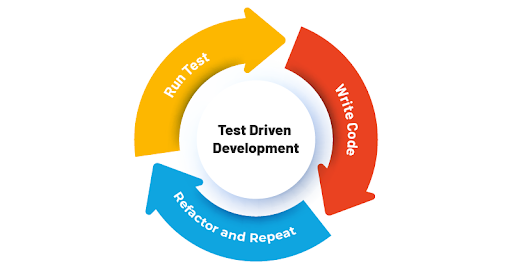
- Agilemania
- May 17th 2022
If there’s one thing that both large and small organizations desire, it’s to create a product that drives a tangible business result. When this is the goal, the term TDD or Test Driven Development can often be seen discussed by developers and management alike.
If you’re new to the term TDD or less familiar with the concept, here’s a concrete guide to help you understand TDD, its process, benefits, and much more. Let’s go!
What is TDD?
Test-Driven Development (TDD) refers to the practice of writing a piece of code only if the automated test has failed. The approach states that one should write “implementation code” only if there is a “failing test case”. It is an iterative approach for developing software products where –
- A failing test case is written.
- Enough business code is created, which makes the failing test case pass.
- Then, if needed, the entire code is refactored.
- Finally, the entire process is repeated, creating more tests over a period of time.
Understanding the TDD Process
Here is a step-by-step process demonstrating how TDD works- 1. Run a test and see if it fails: Write a unit function for the test that will be implemented. The test shouldn’t be too long and should be enough to focus on only one behavior of the function. Write minimal code that meets the requirements. It’s now time to run the test and check if it fails. A test that shows a negative result means you’re on the correct track, and it was no beginner’s luck. Failure here is good.
2. Write the correct code that delivers a positive result: Write the bare minimum supporting code that is correct enough to pass the test. If the code makes the cut, move on. Do the test again and confirm if it passes.
3. Refactor till needed: After passing the test, start refactoring without splitting the code. Evaluate the code and look for areas of improvement to ensure the code is clean. Eliminate duplicate code by adding new features. Strengthen the design system to power up solutions. Once finished with refactoring and run the tests again so that you pass. Repeat until no longer required.
Learn Test-Driven Development- Enroll Now for the Test-Driven Development(TDD) Training
Benefits of TDD
1. Fails Fast: The unique thing about TDD is that it allows you to fail fast. This helps in making the feedback loop short, enabling the development team to know if the code is correct. Developers can do a self-assessment and manual acceptance test, and peer-to-peer review is done. The result? Reduced turnaround time, which leads to minimum defects during testing.
2. Promotes continuous change: As is the norm, most developers work on the same code together. When a single developer gets down to work, continuous integration tools will identify the change and immediately run the unit tests, testing the code within a few minutes. All failures are reported to the developers, and the issues are resolved before manual or integrated testing and before it reaches the end users.
3. Clear documentation of code: TDD uses unit tests which serve as good documentation like others. This spares the time-consuming and laborious task of writing documentation that is unsustainable to maintain in the long run.
4. Design is divided into phases: When using the TDD approach, developers focus on a small batch of code at a time, not moving on to the next bit until they are done with their batch. If written in this manner, the code quality is naturally enhanced, making it easier to discover bugs without much fuss and reuse small portions of code to make new features. This ultimately improves solution architecture. This corresponds to modular software design principles and also teaches developers to keep the code clean.
5. Easy maintenance code: Working by necessity with code arranged in a specified order is much easier when changes and modifications need to be made. When developers work according to the test-driven development approach, they naturally produce cleaner, more readable, and more manageable code.
Focusing on smaller and more digestible code chunks makes it easier for developers to adhere to test requirements and puts less stress on them, and in turn, makes it easier for them to handle other tasks at hand. Cleaned up original code especially comes in handy when the task or project is transferred to different members of the product team.
6. Refactor constantly: It's always a good idea to review your work at the end of each day. One strategy is to run all the tests, see where they fail, and deal with them one by one. When you fix one aspect of a program, it can indirectly affect other parts that were previously working fine.
Sometimes there are conflicts in these changes, and it may be necessary to make ongoing adjustments between the various tests, so that is why making sure you have a robust test environment is so important. The main aim of refactoring code is to improve its ability to tell you — the author — what it’s doing. By getting feedback from code, we can ensure it works as expected all of the time, every time.
7. Project costs decrease and increase in ROI: With test-driven development at the core of your workflow, you can create quality software faster. Fewer bugs mean less time spent debugging and building up new features; in turn, there is less rework, and it’s more economical.
Drawbacks of TDD
While there are many benefits of TDD, there are certain disadvantages as well that you should know.
1. Speed: The main drawback of TDD is the speed with which the development progresses. While TDD is the best option when it comes to developing a quality product, it definitely slows down the development speed till it becomes the culture and mindset of the team.
2. Maintenance Test: Maintaining test code is, by default, necessary in TDD. When the product requirements evolve, functionality tests need to be revised and followed up with changes in the implementation code. There are ample opportunities to eliminate unnecessary tests based on the nature of the system.
3. Steep Learning Curve: TDD isn’t as simple as it seems. It has a steep learning curve and requires utmost dedication and practice as it is different from conventional systems. While it does take up a major chunk of your time, in the longer run, you will benefit from it. Making rigorous tests easy is an uphill task and can only be done with experience.
4. Dedicated Time: TDD works only if the entire team believes in it. Mixed beliefs about TDD will result in failure, and it's best not to adopt it if that’s the case. Unit testing must be done diligently or else TDD will only fail without a trace.
Recommended reading: TDD vs BDD: Know The Difference








